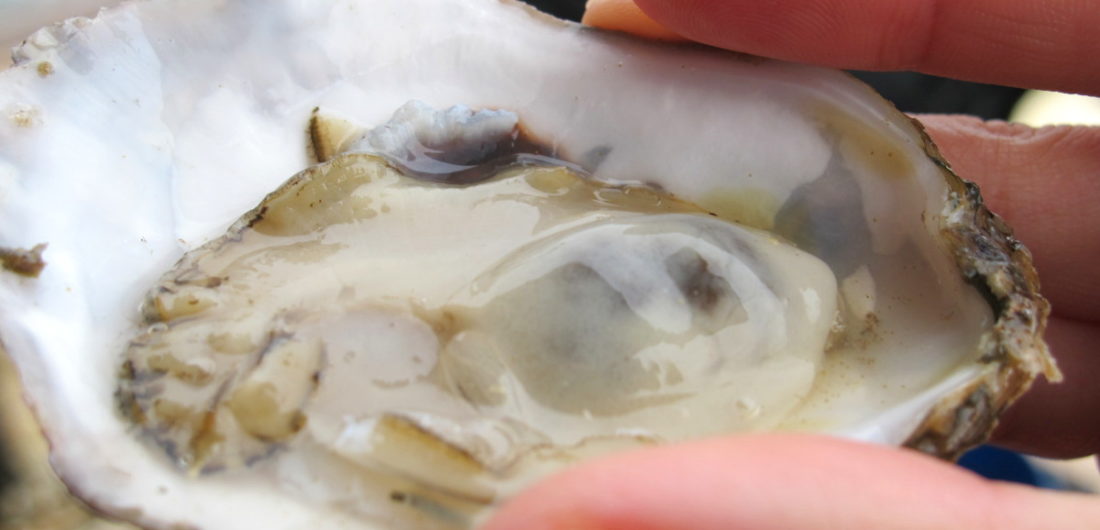“Anyone want to try one, or is it too early in the day for that?” asked Graham Brawley, sales director for Ocean State Shellfish Coop and our guide for the day. I nodded my enthusiasm; it’s never too early for oysters in my opinion. With superhuman agility and no protective towel, Brawley popped open the oysters and passed them over. Fresh out of the water, the oysters were overflowing with briny liquor, rich with a meaty mushroom finish. I tipped one back and took a second. And a third.
After all, oysters may soon be going the way of the dodo bird.
Is that overly alarmist? I’m not saying oysters are particularly rare today, or that they’ll be wiped out next year. But the prognosis for oysters, shellfish, coral reefs and many other calcifying sea creatures is not looking good. The culprit? Global warming’s silent evil twin: ocean acidification.
You’ve probably heard about the rising levels of carbon dioxide in our atmosphere and how it’s changing our climate. What you may not know is that the ocean has played a huge role in tempering the effects of this carbon dioxide—about 1/3 of the carbon dioxide added to the atmosphere since the start of the Industrial Revolution has been absorbed by the ocean. However, we’re beginning to realize that this comes at a cost. The excess carbon dioxide is causing unprecedented changes in the chemistry of the oceans, making the waters more acidic and less plentiful in carbonate ions, which are used to build shells. Already, the pH of seawater has decreased by about 0.12 pH units, or a 30% rise in acidity. By 2100, the shallow waters of the ocean (<150 meters) are projected to decrease by an additional 0.2-0.3 pH units, or a rise of 100-150% in acidity since the 18th century.
 A shell placed in seawater with increased acidity slowly dissolves over 45 days. Source: NOAA
A shell placed in seawater with increased acidity slowly dissolves over 45 days. Source: NOAA
Let’s put into perspective what these numbers might mean. About 55 million years ago, during the Paleocene-Eocene Thermal Maximum, the planet experienced a dramatic increase in atmospheric carbon dioxide, causing massive extinctions and major changes in biodiversity. Today, the ocean is acidifying at a rate nearly 10 times faster than the period that drove the extinctions 55 million years ago.
So, how long until we see the effects of these changes? Actually, the Pacific Northwest is already seeing the impacts of ocean acidification. In the mid-2000s, oyster hatcheries in Oregon and Washington experienced mysterious failures. Baby oysters were disappearing in droves, with production down to 20-30% of normal levels. Scientists eventually determined that changing ocean chemistry, not disease, was the culprit. Juvenile larvae are particularly sensitive to ocean pH, and their shells are more likely to dissolve in low pH conditions. Outside of the hatcheries, wild oysters have not fared much better—there has been very little natural seed set in Willapa Bay since 2005.
The stopgap solution for oyster hatcheries is to install seawater monitoring equipment, and to selectively draw water into hatchery tanks only when conditions are favorable. To protect the 3,200 jobs and $270 million contributed annually by the aquaculture industry, Washington’s government has allocated $3.3 million for research. Oyster hatcheries have also built new facilities in locations where the water is currently less corrosive, like Hawaii. How much longer these favorable water conditions will hold is anyone’s guess.
If you are not an avid fan of oysters or shellfish, consider the ecosystem impacts that the disappearance of calcifying sea creatures would have. Coral reefs would dissolve, leaving large numbers of fish without physical protection. Fish that eat calcifying plankton and shellfish will be left hungry, causing ripple effects up the food chain for their predators. The commercial fishing industry will struggle, and the one billion people who get the majority of their protein from the ocean will suffer.
To date, East Coast fisheries have not seen as many impacts from ocean acidification, but that doesn’t mean they won’t be apparent in the next 20 years or so. In the meantime, we need to act now to preserve our shellfish, along with the other sea creatures, ecosystems and livelihoods that depend on them.
Here’s what we need to do:
- Spread Awareness: Talk about ocean acidification with your buddies at the clam shack, your restaurant industry friends, your dinner party guests. Let them know that our oceans are in trouble, and it’s going to have big impacts on our clam chowder and beyond. According to surveys, only 14% of Americans are even aware of ocean acidification, much less concerned about it.
- Support Your Oystermen and Fishermen: The seafood industry is in for a rough ride in coming years, with the potential for big fluctuations in supply. Support your oyster growers and fishers, and be understanding if prices rise.
- Fund Research: Scientists have had some success in locally buffering ocean acidification by raising oysters in eelgrass beds. It may also be possible to selectively breed oysters that are more tolerant of acidic ocean conditions. To develop long-term solutions, coastal state governments and universities should be vigorously monitoring seawater chemistry and researching what we can do for permanent fixes.
- Reduce Carbon Emissions: This is the root of the issue and ultimately, it’s going to take concerted action by the world’s governments to resolve the problem. We need clean energy alternatives, or our planet will be fundamentally changed by 2100. We can also reduce our personal carbon footprints by taking mass transit, using energy-efficient CFL bulbs, and bringing shopping bags with us.
If we don’t find some way to halt or slow the effects of ocean acidification, we may be looking at a seafood menu of kelp and jellyfish in a few decades. While this alone is not the greatest tragedy, a world without fried clams and crab cakes would be much sourer indeed.
